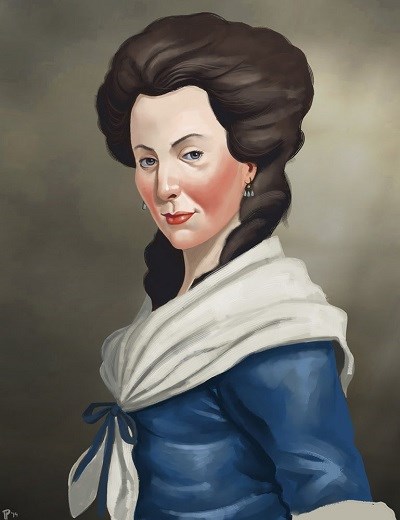
Historians often credit Eliza Lucas Pinckney (1722-1793) with perfecting the growth of indigo as a major cash crop in South Carolina. Her unique situation as a female plantation manager defied the social expectations of the Charleston elite. Through exploitation of enslaved workers, Eliza Lucas Pinckney established a plantation empire giving her access to wealth and status.
Colonel Lucas moved his family from Antigua to the Charleston area in 1738. The Lucas family owned three Lowcountry tracts of land- Garden Hill Plantation, Wappoo Plantation, and 3,000 acres on the Waccamaw River near Georgetown. They had plans to live in the area long term, but unfortunately, her mother died shortly after the journey from the Caribbean to South Carolina. Due to Eliza being the eldest child in the family, and with her two younger brothers Thomas and George at school in England, she had to step up as matriarch at a very young age. With increasing tension between England and Spain, Colonel Lucas was called back to Antigua for political reasons, leaving Eliza in a very difficult position. She stayed at Wappoo Plantation, 3 miles Southwest of Charleston, managing the family plantations and enslaved workers on her father’s behalf. She wrote to her friend Mary Bartlett: “I am making a large plantation of oaks, which I took upon as my own property, whether my father gives me the land or not.” She believed the oaks would be “more valuable than they are now—which you know they will be when we come to build fleets.” She could be found visiting the home of Charles (1699-1758) and Elizabeth Lamb Pinckney on occasion. The Pinckneys acted as guardians and friends to Eliza while her father remained in Antigua. Her relationship with the Pinckneys was quite close. Charles Pinckney was very skeptical of Eliza’s interest in planting. He wrote, “Tell the little visionary come to town and partake of some of the amusements suitable to her time of life.” To which she responded “Pray tell him…what he may now think whims and projects may turn out well by and by. Out of many surely one may hit.” And one did—Indigo. Years of persistence paid off, and in 1744, she was able to grow enough indigo to begin the process of dye production. In the hot, humid conditions, processing the plant to produce the light wash blue dye was exhausting. Several plantations in the area continually tried, and failed, to successfully create the dye. Under the guidance of a Frenchman from Monserrat, sent by her father, Eliza was able to send a small sample of indigo dye to Great Britain. She saw success and was ready to continue to grow the crop at a larger scale. However, the same year brought her devastating news- Her father wanted the family to return to Antigua, and her dear friend Elizabeth Lamb Pinckney died. Eliza managed to continue working directly with plantation operations while her family grew. While raising their young family, Charles Pinckney contracted malaria, and died in 1758. Eliza remained a widow the rest of her life, continuing to manage the plantations her husband left behind. She experimented with other crops and products, such as silk, in an attempt to sustain her family and attain higher wealth. She sent a substantial export of indigo to England as proof of her efforts. In addition to economic motives, indigo production also succeeded in the Lowcountry because it fit within the existing agricultural economy. The crop could be grown on land not suited for rice and tended by enslaved people, so planters and farmers already committed to plantation agriculture did not have to reconfigure their land and labor. In 1747, 138,300 pounds of dye, worth £16,803 sterling, were exported to England. The amount and value of indigo exports increased in subsequent years, peaking in 1775 with a total of 1,122,200 pounds, valued at £242,295 sterling. England received almost all Carolina indigo exports, although by the 1760s a small percentage was being shipped to northern colonies.
By the beginning of the American Revolution, indigo made up one third of the exports from South Carolina. In less than fifty years, the market had grown substantially. However, the tension with the British and the establishment of the East India Trading Company led to the diminishing of the Carolina indigo trade. After 1776 as the United States established itself as an independent nation, trade with England essentially ceased. Indigo remained a popular commodity within the region, and was traded with other states’ resources. Eliza remained a widow the rest of her life. She saw her children go on to be married, and to have lasting impacts on the foundation of the United States as they lived through the American revolution. Because her letterbooks stop mid 1760s, historians have had to piece together her later years of life through newspaper articles, journals of family members and friends, etc. In her 70s, she developed breast cancer. Eliza’s family made the decision to bring her to Philadelphia, to receive the most up to date medical treatment. She passed away at age 71 in 1793, and is buried in St. Peter’s Churchyard in Philadelphia, Pennsylvania. George Washington, by his own request, was a pallbearer at her funeral. Her impact was felt nationwide.
|
Last updated: February 12, 2025
